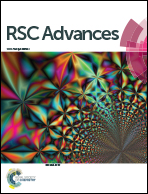Hierarchical Co(OH)2@NiMoS4 nanocomposite on carbon cloth as electrode for high-performance asymmetric supercapacitors†
Abstract
Hierarchical Co(OH)2@NiMoS4 nanocomposites were successfully prepared on a carbon cloth by using a simple two-step hydrothermal method coupled with a room-temperature vulcanization method. The resulting nanocomposites were composed of large-scale uniform Co(OH)2 nanowires fully covered with ultrathin vertical NiMoS4 nanoflakes. Because of the synergetic effect between Co(OH)2 and NiMoS4, the nanocomposites exhibited good electrochemical performance as a supercapacitor electrode. In particular, a specific capacity of 2229 F g−1 was achieved at a current density of 1 A g−1. In addition, an asymmetrical supercapacitor fabricated using activated carbon as the negative electrode and the as-synthesised nanocomposite as the positive electrode exhibited a maximum energy density of 59.5 W h kg−1 at a power density of 1 kW h kg−1 and excellent cycling stability (100% capacitance retention after 5000 cycles). These results indicate that the hierarchical Co(OH)2@NiMoS4 nanocomposite has great potential for practical application in high-performance energy storage devices.



 Please wait while we load your content...
Please wait while we load your content...